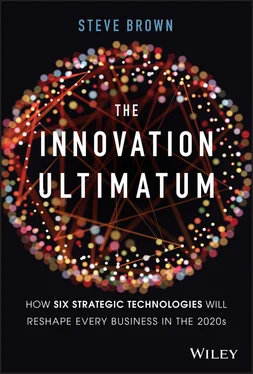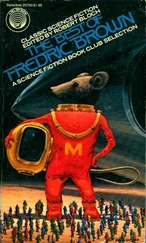This is the power of Steve Brown's work as a futurist. He has spent years empowering organizations to make well informed decisions about the future. Sometimes they might be difficult decisions, but ultimately his goal is to give organizations the vision and perspective to not only plan for the future but get excited about it. This book is a valuable tool for people to become informed about the future and begin the necessary conversations about how to prepare for—and thrive in—the coming tomorrows.
Brian David Johnson, author and futurist
Arizona State University
Introduction To Survive, Every Company Must Become a Tech Company
Innovate—or die.
This business maxim has never been truer than it is today. Consumers are demanding and fickle. Their expectations are set by the best and most recent experiences they've had. They have no tolerance for companies that skate by and that don't constantly strive for excellence. Consumers expect brands not only to deliver, but surprise. There is a massive and rapidly widening gulf between the capabilities of companies that invest in technology and those that don't.
It is a time of reckoning. Emerging technologies will empower brave innovators to make giant leaps forward, while those without vision, courage, and agility will wither and perish. Winners will change the world.
It's no coincidence that most of the companies on the Brand Z list of the top 100 most valuable global brands invest heavily in technology to drive innovation into every aspect of their business: product development, operations, marketing, and customer service.
In the next decade, a suite of six strategic technologies—artificial intelligence (AI), Blockchain, the Internet of Things (IoT), augmented reality, autonomous machines, and 5G networks—will drive unprecedented innovation into products and services, creating entirely new business models along the way. Investment in information technology (IT) will be a strategic imperative for every company. Every company will become a technology company, and every company will become a data company. Business operations will be retooled using both process automation and worker augmentation.
Automation and Augmentation
Automation will speed business processes, improve quality, and reduce costs. Augmentation will elevate the capabilities of workers, blending machine and human intelligence. Artificial intelligence will assist us, partner with us, guide us, inspire us, and make us even more capable. We don't need to merge with technology to collaborate closely with it.
Product, Service, and Business-Model Innovation
New products and services are the best way to retain existing customers and gain new ones. In the next decade, expect significant innovation in products and services as technology becomes embedded inside anything and everything. Companies will use data, sensors, and machine intelligence to elevate business models and get paid more for their efforts, moving upward from products to services, services to experiences, and experiences to transformations.
In the coming years, we will see the broad deployment of six important technologies. Think of these technologies as six new colors being added to your business innovation palette. To some extent, your ability to innovate will only be limited by your imagination.
Six Technologies Intimately Connect the Digital and Physical Worlds
Each of these six technologies builds a bridge between the digital world and the physical world. Computing capabilities, and value created in the digital world, both advance exponentially. As we build ever more intimate connections between the digital and physical worlds, more of that value flows across the bridge to be experienced in the physical world.
Engineers have been building this bridge for several decades now. This, in itself, is not a new story. But the next decade will dramatically accelerate the building of the digital–physical bridge. Trillions of sensors will enable the digital world to understand what's happening in our physical world. Robots and other autonomous machines will enable the digital world to act within the physical world. Artificial intelligence will give digital devices eyes and ears so they can make sense of the world. Distributed ledgers and Blockchains, combined with arrays of sophisticated sensors, will track the movement of physical goods around the planet. Augmented reality will blend digital objects and information with our visual perception of the physical world. Finally, 5G networks and satellite constellations will tie everything together, allowing everything to connect with everything else.
This is an exciting (and daunting) time to be in business. Competition is fierce. Customers are never satisfied; neither are shareholders. In the 2020s, the companies that thrive will be the ones that never rest on their laurels. These companies will fully embrace every one of these six technologies and combine them in creative ways to leapfrog competition. Those that hesitate risk irrelevance. Nobody is immune, not even today's titans. Winners will create massive value in the digital domain and use the six technologies to bridge that value into the physical realm, streamlining operations, delighting customers, and creating exciting new products and services.
Winners Will Wield and Combine These Technologies Like Artists Use Color
The six technologies that are the focus of this book aren't all brand new. The term “artificial intelligence” was coined in the 1950s, the ideas behind the Internet of Things have been around since the last century, and Blockchains were first created more than a decade ago. For various reasons, each is only just coming to maturity. It is the creative combination of these technologies that will lead to breakthrough innovation. For example, IoT sensors are made exponentially more powerful with AI. Next-generation, massively scalable distributed ledger technology will combine with ubiquitous low-earth-orbit satellite networks to transform logistics and the supply chain.
As innovators seek to reimagine how they create value, serve customers, and operate their businesses, new technologies act like new colors in their creative palette. The most impressive innovations will be painted using a creative combination of many colors. Uber was created at the intersection of apps, GPS sensors, cloud services, and the gig economy.
Expect More Change in the Next 10 Years Than the Last 40
New technologies change the innovation landscape forever. Some technologies have a much larger impact than others. Since the 1980s, four major technological leaps defined the innovation landscape for business IT: the PC, the web, mobile, and the cloud. When IBM launched its personal computer in 1981, it kicked off an upward spiral of innovation and productivity. In the early 1990s, the rise of the web meant that every business had to open a new front door, online. Steve Jobs kicked off the mobile revolution in 2007 and put a portable supercomputer into the pockets and purses of billions of people around the world. Finally, the cloud computing era, which occurred concurrently with the mobile era, made it easier for companies to create digital value, scale it on demand, and innovate rapidly. Sure, there were other technologies that were stirred into the mix, but those were the big four. Four decades, four big leaps forward, four new colors in the innovation palette. In a single decade, the 2020s, six technologies will combine to fuel more innovation than in the last 40.
Should I Be Afraid or Excited?
Читать дальше












